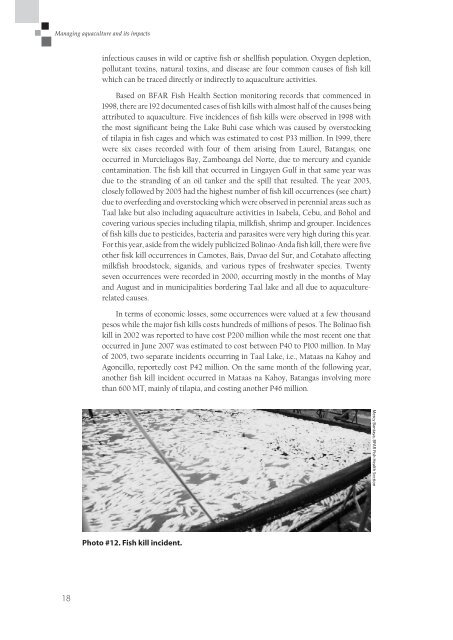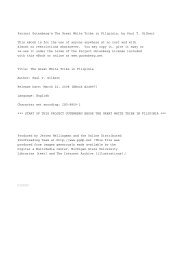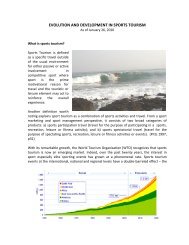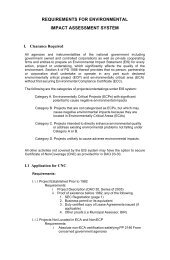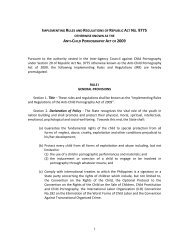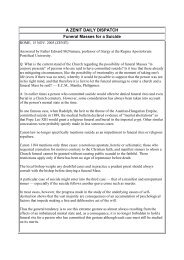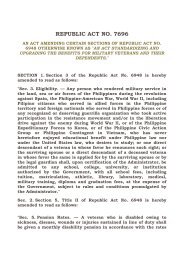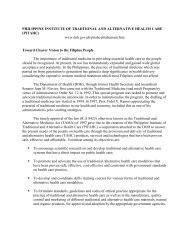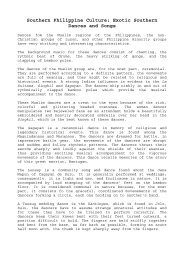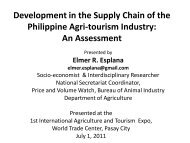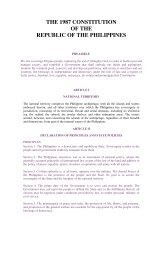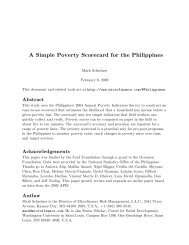Untitled - About the Philippines
Untitled - About the Philippines
Untitled - About the Philippines
You also want an ePaper? Increase the reach of your titles
YUMPU automatically turns print PDFs into web optimized ePapers that Google loves.
Managing aquaculture and its impacts: a guidebook for local governments<br />
infectious causes in wild or captive fish or shellfish population. Oxygen depletion,<br />
pollutant toxins, natural toxins, and disease are four common causes of fish kill<br />
which can be traced directly or indirectly to aquaculture activities.<br />
Based on BFAR Fish Health Section monitoring records that commenced in<br />
1998, <strong>the</strong>re are 192 documented cases of fish kills with almost half of <strong>the</strong> causes being<br />
attributed to aquaculture. Five incidences of fish kills were observed in 1998 with<br />
<strong>the</strong> most significant being <strong>the</strong> Lake Buhi case which was caused by overstocking<br />
of tilapia in fish cages and which was estimated to cost P33 million. In 1999, <strong>the</strong>re<br />
were six cases recorded with four of <strong>the</strong>m arising from Laurel, Batangas; one<br />
occurred in Murcieliagos Bay, Zamboanga del Norte, due to mercury and cyanide<br />
contamination. The fish kill that occurred in Lingayen Gulf in that same year was<br />
due to <strong>the</strong> stranding of an oil tanker and <strong>the</strong> spill that resulted. The year 2003,<br />
closely followed by 2005 had <strong>the</strong> highest number of fish kill occurrences (see chart)<br />
due to overfeeding and overstocking which were observed in perennial areas such as<br />
Taal lake but also including aquaculture activities in Isabela, Cebu, and Bohol and<br />
covering various species including tilapia, milkfish, shrimp and grouper. Incidences<br />
of fish kills due to pesticides, bacteria and parasites were very high during this year.<br />
For this year, aside from <strong>the</strong> widely publicized Bolinao-Anda fish kill, <strong>the</strong>re were five<br />
o<strong>the</strong>r fisk kill occurrences in Camotes, Bais, Davao del Sur, and Cotabato affecting<br />
milkfish broodstock, siganids, and various types of freshwater species. Twenty<br />
seven occurrences were recorded in 2000, occurring mostly in <strong>the</strong> months of May<br />
and August and in municipalities bordering Taal lake and all due to aquaculturerelated<br />
causes.<br />
In terms of economic losses, some occurrences were valued at a few thousand<br />
pesos while <strong>the</strong> major fish kills costs hundreds of millions of pesos. The Bolinao fish<br />
kill in 2002 was reported to have cost P200 million while <strong>the</strong> most recent one that<br />
occurred in June 2007 was estimated to cost between P40 to P100 million. In May<br />
of 2005, two separate incidents occurring in Taal Lake, i.e., Mataas na Kahoy and<br />
Agoncillo, reportedly cost P42 million. On <strong>the</strong> same month of <strong>the</strong> following year,<br />
ano<strong>the</strong>r fish kill incident occurred in Mataas na Kahoy, Batangas involving more<br />
than 600 MT, mainly of tilapia, and costing ano<strong>the</strong>r P46 million.<br />
Mercy Bantaya, BFAR Fish Health Section<br />
Photo #12. Fish kill incident.<br />
18


